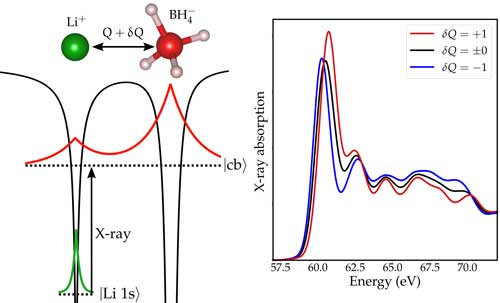| Posted: Feb 07, 2017 |
Ultrasmall atom motions recorded with ultrashort x-ray pulses
(Nanowerk News) Periodic motions of atoms over a length of a billionth of a millionth of a meter (10-15 m) are mapped by ultrashort x-ray pulses. In a novel type of experiment, regularly arranged atoms in a crystal are set into vibration by a laser pulse and a sequence of snapshots is generated via changes of x-ray absorption.
|
|
A crystal represents a regular and periodic spatial arrangement of atoms or ions which is held together by forces between their electrons. The atomic nuclei in this array can undergo different types of oscillations around their equilibrium positions, the so-called lattice vibrations or phonons. The spatial elongation of nuclei in a vibration is much smaller than the distance between atoms, the latter being determined by the distribution of electrons.
|
|
Nevertheless, the vibrational motions act back on the electrons, modulate their spatial distribution and change the electric and optical properties of the crystal on a time scale which is shorter than 1 ps (10-12 s). To understand these effects and exploit them for novel, e.g., acoustooptical, devices, one needs to image the delicate interplay of nuclear and electronic motions on a time scale much shorter than 1 ps.
|
 |
| In an x-ray absorption experiment light excites a strongly bound core electron into a conduction band state. On the left of the figure such a transition is shown. An electron which is strongly bound to a Lithium nucleus (green) is excited into a conduction band state (red) that interacts with both the Lithium nucleus and Borohydride group. This conduction band state is therefore sensitive to a modulation of the distance Q between Lithium nucleus and Borohydride group and as a result the x-ray absorption process is sensitive to such a modulation. On the right side of the figure the Lithium K-edge x-ray absorption spectrum for different strongly exaggerated displacements is shown. (click on image to enlarge)
|
|
In a recent Rapid Communication in Physical Review B ("Ultrafast modulation of electronic structure by coherent phonon excitations"), researchers from the Max Born Institute in Berlin (Germany), the Swiss Federal Laboratories for Materials Science and Technology in Dübendorf (Switzerland), and the National Institute of Standards and Technology, Gaithersburg (USA) apply a novel method of optical pump - soft x-ray probe spectroscopy for generating coherent atomic vibrations in small LiBH4 crystals, and reading them out via changes of x-ray absorption.
|
|
In their experiments, an optical pump pulse centered at 800 nm excites via impulsive Raman scattering a coherent optical phonon with Ag symmetry. The atomic motions change the distances between the Li+ und (BH4)- ions.
|
|
The change in distance modulates the electron distribution in the crystal and, thus, the x-ray absorption spectrum of the Li+ ions. In this way, the atomic motions a mapped into a modulation of soft x-ray absorption on the so-called Li K-edge around 60 eV. Ultrashort x-ray pulses measure the x-ray absorption change at different times. From this series of snapshots the atomic motions are reconstructed.
|
|
This novel experimental scheme is highly sensitive and allows for the first time to kick off and detect extremely small amplitudes of atomic vibrations. In our case, the Li+ ions move over a distance of only 3 femtometers = 3 x 10-15 m which is comparable to the diameter of the Li+ nucleus and 100000 times smaller than a distance between the ions in the crystal.
|
|
The experimental observations are in excellent agreement with in-depth theoretical calculations of transient x-ray absorption. This new type of optical pump-soft x-ray probe spectroscopy on a femtosecond time scale holds strong potential for measuring and understanding the interplay of nuclear and electronic motions in liquid and solid matter, a major prerequisite for theoretical simulations and applications in technology.
|

